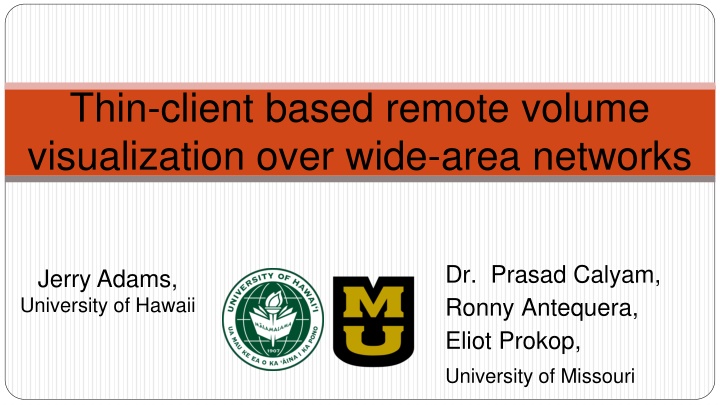
Enhancing Remote Volume Visualization Over Wide-Area Networks with Thin-Client Technology
Explore the innovative approach of thin-client-based remote volume visualization over wide-area networks, focusing on achieving the best Quality of Experience (QoE) in Remote Desktop Access (RDA) applications. Discover solutions to improve QoE through dynamic VNC encoding selection schemes, shared GPU virtualization, and OpenFlow controllers. Delve into related works, problem statements, and advancements in the field to optimize the overall user experience in RDA applications.
Download Presentation

Please find below an Image/Link to download the presentation.
The content on the website is provided AS IS for your information and personal use only. It may not be sold, licensed, or shared on other websites without obtaining consent from the author. If you encounter any issues during the download, it is possible that the publisher has removed the file from their server.
You are allowed to download the files provided on this website for personal or commercial use, subject to the condition that they are used lawfully. All files are the property of their respective owners.
The content on the website is provided AS IS for your information and personal use only. It may not be sold, licensed, or shared on other websites without obtaining consent from the author.
E N D
Presentation Transcript
Thin-client based remote volume visualization over wide-area networks Dr. Prasad Calyam, Ronny Antequera, Eliot Prokop, University of Missouri Jerry Adams, University of Hawaii
Presentation Outline Background Related Work Problem Implementation VNC Encoding Selection Scheme Shared GPU Virtualization OpenFlow Controller 2
Background Remote Desktop Access (RDA) Applications are prevalent Achieving best Quality of Experience (QoE) in RDA Applications essential QoE is an interplay of: Quality of Application (QoA) Quality of Service (QoS) 3
Related Work (1/4) Human-Aware and Network-Aware Encoding Selection Scheme for Remote Instrumentation Considers both the condition of the network and the human perceived performance of the application Using RICE application as a case study, proves Human and Network Aware encoding selection is superior 4
Related Work (2/4) ADON: Application-Driven Overlay Network-as-a- Service for Data-Intensive Science QoS improvements via Software-defined network (SDN) techniques. Case study tested network improvements over four different RDA applications 5
Related Work (3/4) Remote Desktop QoE Optimization Through Context Awareness 3Q Decision Tree Model proposed QoA and QoS improved to optimize the overall QoE 6 ?
Problem What are ways to improve the overall quality of experience of a RDA application? 7
Problem What are ways to improve the overall quality of experience of a RDA application? Dynamic VNC encoding selection scheme Shared GPU Virtualization OpenFlow Controller 8
RIVVIR Application (1/2) Remote Interactive Volume Visualization Infrastructure for Researchers (RIVVIR) Access remote computing resources and data intensive applications Used as a case study to test and verify improvements 9
RIVVIR Application (2/2) Computing Resources @ OSU Thin client end users @ MU 10
VNC Encoding VNC Open source remote control protocol, based on Remote Frame Buffer protocol Ultra VNC VNC client that s used to connect to RIVVIR Encoding encoding of pixels to transport the image data 15
VNC Encoding Schemes Will be testing 8 encoding schemes: Tight, ZRLE, Zlib, ZlibHex, Ultra, Hextile, RRE, Raw Each encoding scheme supports 4 color options: Full Colors, 256 Colors, 64 Colors, 8 Colors 16
Dynamic VNC Encoding Selection Have RIVVIR to dynamically choose best encoding scheme based on network conditions such as: Available Bandwidth Packet Loss 18
Preliminary Encoding Decision Rules Available Bandwidth Encoding Available Bandwidth > 1 Mbps Hextile full colors 256 Kbps > Available Bandwidth > 128 Kbps ZRLE 256 colors 128 Kbps > Available Bandwidth > 19 Kbps Tight 64 Colors 19 Kbps > Available Bandwidth > 5 Kbps Tight 8 colors 19
Roadmap for Encoding Selection Perform more tests of encoding types on different network conditions Improve decision rules and algorithim 21
Shared Virtualized GPU What is shared virtualized Graphics Processing Unit (GPU)? Allows a virtual machine (VM) to behave as if it has its own physical, dedicated GPU. The hypervisor (ESXi) sits between the physical GPU and VM, intercepting API calls and translating commands. More effective GPU acceleration for VMs than other virtualization methods 22
Test Shared Virtualized GPU Apply Shared Virtualization GPU to RIVVIR server Run graphic intensive workloads on RIVVIR Capture performance metrics such as VM consolidation, response time and remote FPS 26
Performance Metrics VM Consolidation - number of VMs that can be supported concurrently on a server until CPU utilization < 80% Response time - measurement of the VM's response time in seconds from when an image is fully loaded on the remote client Remote FPS - number of remotely delivered frames per second that correspond to frame updates generated by the server 27
Roadmap for Shared GPU Virtualization Perform test on RIVVIR application Analyze results 28
OpenFlow A protocol that gives access to the forwarding plane of a network switch or router over the network Allows for Software-Define Networking 29
OpenFlow Controller OpenFlow Controller remote software that controls the network switch or router. Many available. RIVVIR application uses Open Floodlight Includes a module that enables QoS Open Floodlight Controller allows for: Path switching Bandwidth allocation Shortest-cost routing 30
Test OpenFlow Controller Network Emulator Computing Resources @ OSU Thin client end users @ MU 31
Roadmap for OpenFlow Test OpenFlow controller on RIVVIR application Analyze results 32
Thank you. Any questions? 33
